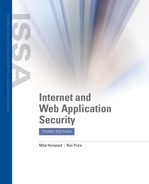Types of Information Security
The term “information security” covers several types of security for different types of information, a lot of different security tools and methods, and a lot of different domains where security is needed. Yes, that is a lot of differences, but just think of the number of combinations this could mean. The point of this is that there really is not a one-size-fits-all type of information security. What policies, safeguards, methods, measures, and countermeasures are appropriate for any particular business or organization depends on that business or organization. In this section, we look at the various categories of information security and the strategies, tools, and policies each defines.
Information security is made up of several subtypes, many of which you should know to better your chances for developing and implementing a robust security program. You should know the information security subtypes:
-
Application security
-
Infrastructure security
-
Cloud security
Application Security
Application security is the information security subtype focused on protecting web applications and APIs. Unsecured applications and API vulnerabilities may give an attacker an open door to other network elements and, especially, your data.
According to the Verizon Data Breach Investigations Report (DBIR) for 2020, web app attacks have increased significantly since 2019. In the information industry, preventing the exploitation of web app vulnerabilities and the use of stolen login credentials are ongoing battles. This industry segment sees more web app attacks than other type of business. However, it also has the highest rate of timely vulnerability mitigation among all business types.
Infrastructure Security
Maintaining a balance between hardware and software dependencies and quality communication is another challenge facing the information industry. Typically, this is a challenge faced by a business or organization’s IT department rather than the industry on the whole. Communication connectivity is no longer only limited to servers and workstations and a peripheral device or two. Other devices, such as mobile devices, client devices, and remote data centers have joined the network and rely on the availability and function of the communication network.
Unfortunately, communication can provide a conduit from other locations of a network to any vulnerability on its infrastructure. If, as a result of the vulnerability being exploited, one segment of a network is compromised and fails, any dependent network components also fail or become unavailable. So the primary goal of establishing infrastructure security is to minimize dependencies by isolating key components and to provide dependable communication services.
Cloud Security
As cloud computing becomes adopted by more and more organizations, the issue of cloud security is becoming important. Individual users and businesses, large and small, have discovered and are using applications, programming platforms, and complete systems by subscribing to SaaS, Platform as a Service (PaaS), Infrastructure as a Service (IaaS), and other cloud services that fit a specific need for a subscriber. The security issues of the cloud are the same ones a corporate data center would see, but the security issues are compounded by conditions like multi-tenancy, high-volume attached storage, virtualization, and scalability of service on demand.
When you consider that a cloud service is a shared resource that is accessed on the public network, typically from an office or open-area workspace, it should come as no surprise that there is every opportunity for the exploitation of the service. Cloud computing is new and not every company hoping to become a cloud service provider (CSP) is necessarily a cloud, systems, or security guru. A misconfigured cloud system is easily a target.
The security of a cloud system is a shared responsibility. The subscriber would like to believe that the provider is taking care of it, and the provider sees that the subscriber must contribute to the overall security of the system. Each does have a role in securing the system: the subscriber must secure the remote access to the system and the provider must implement security against penetration and data loss, among others. Tools such as a Cloud Security Posture Management (CSPM) system and a Cloud Workload Protection Platform (CWPP) provide information security professionals a way to view activity on the cloud infrastructure to identify and locate any vulnerabilities and, in many cases, automatically resolve the situation.
